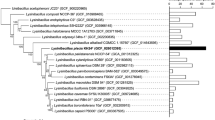Abstract
In order to monitor Lactobacillus plantarum and Oenococcus oeni in red wine produced with Italian grape (variety “Primitivo di Puglia”), a polymerase chain reaction– denaturing gradient gel electrophoresis (PCR-DGGE) approach using the rpoB as gene target was established. Wine was treated or not with potassium metabisulphite and supplemented with a commercial bacterial starter of O. oeni to encourage malolactic fermentation. Samples were taken from the vinification tanks at 4, 10, 16, 22, and 28 days after the start of alcoholic fermentation. Genomic DNA was directly isolated from wine and identification of lactic acid bacteria was performed using primers rpoB1, rpoB1O, and rpoB2 able to amplify a region of 336 bp corresponding to the rpoB gene. Amplified fragments were separated in a 30–60% DGGE gradient, and the ability of the PCR-DGGE analysis to distinguish L. plantarum and O. oeni was assessed. The results reported suggest that the PCR-DGGE method, based on the rpoB gene as molecular marker, is a reproducible and suitable tool and may be of great value for wine makers in order to monitor spoilage microorganisms during wine fermentation.

Similar content being viewed by others
Literature Cited
Aymerich T, Martin B, Garriga M, Hugas M (2003) Microbial quality and direct PCR identification of lactic acid bacteria and non-pathogenic staphylococci from artisanal low-acid sausages. Appl Environ Microbiol 69:4583–4594
Beneduce L, Spano G, Vernile A, Tarantino D, Massa S (2004) Molecular characterization of lactic acid populations associated with wine spoilage. J Basic Microbiol 44:10–16
Bourdineaud JP, Nehme B, Tesse S, Lonvaud-Funel A (2003) The ftsH gene of the wine bacterium Oenococcus oeni is involved in protection against environmental stress. Appl Environ Microbiol 69:2512–2520
Cocolin L, Manzano M, Rebecca S, Comi G (2002) Monitoring of yeasts population changes during a continuous wine fermentation by molecular methods. Am J Enol Vitic 53:24–27
Cocolin L, Manzano M, Cantoni C, Comi G (2001) Denaturing gradient gel electrophoresis analysis of the 16S rRNA gene V1 region to monitor dynamic changes in the bacterial population during fermentation of Italian sausages. Appl Environ Microbiol 67:5113–5121
Coenye T, Vandamme P (2003) Intragenomic heterogeneity between multiple 16S ribosomal RNA operon in sequenced bacterial genomes. FEMS Microbiol Lett 228:45–48
Coppola S, Blaiotta G, Ercolini D, Moschetti G (2001) Molecular evaluation of microbial diversity occurring in different types of mozzarella cheese. J Appl Microbiol 90:414–420
Da Mota FF, Gomes EA, Paiva E, Rosado AS, Seldin L (2004) Use of the rpoB gene analysis for identification of nitrogen-fixing Paenibacillus species as an alternative to the 16 rRNA gene. Lett Appl Microbiol 39:34–40
Dahllöf I, Baillie H, Kjelleberg S (2000) rpoB-based microbial community analysis avoids limitations inherent in 16S rRNA gene intraspecies heterogeneity. Appl Environ Microbiol 66:3376–3380
Edwards U, Rogall T, Blocker H, Emde M, Bottger EC (1989) Isolation and direct complete nucleotide determination of entire genes. Characterization of a gene coding for 16S ribosomal RNA. Nucl Acid Res 17:7843–7853
Ercolini D (2004) PCR-DGGE fingerprinting: novel strategies for detection of microbes in food. J Microbiol Meth 56:297–314
Ercolini D, Hill PJ, Dodd CER (2003) Bacterial community structure and location in Stilton cheese. Appl Environ Microbiol 69:3540–3548
Kleerebezem M, Boekhorst J, Kranenburg R, et al. (2003) Complete genome sequence of Lactobacillus plantarum WCFS1. Proc Natl Acad Sci USA 100:1990–1995
Liu SQ (2002) Malolactic fermentation in wine–beyond deacidification. J Appl Microbiol 92:589–601
Lonvaud-Funel A (1999) Lactic acid bacteria in the quality improvement and depreciation of wine. Antonie Van Leeuwenhoek 76:317–333
Molenaar D, Bringel F, Schuren FH, de Vos WM, Siezen RJ, Kleerebezem M (2005) Exploring Lactobacillus plantarum genome diversity by using microarrays. Microbiol (SGM) 187:6119–6127
Muyzer G (1999) DGGE/TGGE a method for identifying genes from natural ecosystems. Curr Opin Microbiol 2:317–322
Rantsiou K, Comi G, Cocolin L (2004) The rpoB gene as a target for PCR-DGGE analysis to follow lactic acid bacterial population dynamics during food fermentations. Food Microbiol 21:481–487
Renouf V, Claisse O, Miot-Sertier C, Lonvaud-Funel A (2006) Lactic acid bacteria evolution during wine making: use of rpoB gene as a target for PCR-DGGE analysis. Food Microbiol 23:136–145
Renouf V, Claisse O, Lonvaud-Funel A (2005) Understanding the microbial ecosystem on the grape berry surface through enumeration and identification of yeast and bacteria. Austr J Grape Wine Res 11:316–327
Scheffield VC, Cox DR, Lerman LS, Myers RM (1989) Attachment of a 40-base pair G+C rich sequence (GC-clamp) to genomic DNA fragments by the polymerase chain reaction results in improved detection of single-base changes. Proc Natl Acad Sci USA 86:232–235
Spano G, Beneduce L, Tarantino D, Zapparoli G, Massa S (2002a) Characterization of Lactobacillus plantarum from wine must by PCR species-specific and RAPD-PCR. Lett Appl Microbiol 35:370–374
Spano G, Beneduce L, Tarantino D, Giammanco GM, Massa S (2002b) Preliminary characterization of wine lactobacilli able to degrade arginine. World J Microbiol Biotech 18:821–825
Spano G, Chieppa G, Beneduce L, Massa S (2004) Expression analysis of putative arcA, arcB and arcC genes partially cloned from Lactobacillus plantarum isolated from wine. J Appl Microbiol 96:185–190
Temmerman R, Huys G, Swings J (2004) Identification of lactic acid bacteria: culture-dependent and culture-independent methods. Trends Food Sci Technol 15:348–359
van Beek S, Priest FG (2002) Evolution of the lactic acid bacterial community during malt whisky fermentation: a polyphasic study. Appl Environ Microbiol 68:297–305
Acknowledgments
This work was partially supported by a 60% grant from Foggia University. We would like to thank Dr. Sophie Laurie (BBSRC, Plants, Microbes and Genetics Branch, Polaris House, NorthStar Avenue, Swindon, UK) for her helpful discussion and critical reading of the text.
Author information
Authors and Affiliations
Corresponding author
Rights and permissions
About this article
Cite this article
Spano, G., Lonvaud-Funel, A., Claisse, O. et al. In Vivo PCR-DGGE Analysis of Lactobacillus plantarum and Oenococcus oeni Populations in Red Wine. Curr Microbiol 54, 9–13 (2007). https://doi.org/10.1007/s00284-006-0136-0
Received:
Accepted:
Published:
Issue Date:
DOI: https://doi.org/10.1007/s00284-006-0136-0




